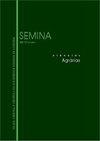间作对咖啡光合活性的影响
IF 0.5
4区 农林科学
Q4 AGRICULTURE, MULTIDISCIPLINARY
引用次数: 0
摘要
开展有助于评价农业生态系统的研究对于促进生物多样性和可持续农业至关重要。本研究旨在评价间作对阿拉比卡咖啡植株光合活性的影响。这项实验是在巴西东南部的阿雷格里市Espírito Santo进行的。研究了三种咖啡种植系统:阿拉比卡咖啡单一栽培;阿拉比卡咖啡间作Nanicon品种香蕉;阿拉比卡咖啡间作Nanicon品种香蕉和juara棕榈。使用的阿拉比卡咖啡品种是Catuaí Vermelho IAC 44,于1991年种植,行间距为3.0米,孔间距为2.0米,每个孔可容纳两株咖啡。2010年,对咖啡树进行了中高修剪(低切修剪),并将Nanicon香蕉种植在行间,间距为5.0 x 3.0 m。三年后,棕榈树幼苗被种植在与香蕉幼苗相同的行中,间距为5 × 3米。每个种植制度随机选择5个试验单元。评价变量包括叶绿素指标(叶绿素a、叶绿素b、总叶绿素和叶绿素a/b比)和气体交换参数(净CO2同化率、气孔导度、胞间CO2浓度、蒸腾、固有水分利用效率、瞬时水分利用效率和羧化效率)。叶绿素指数方面,只有叶绿素b存在差异,单株咖啡的叶绿素值最高。在气体交换方面,间作咖啡的内在水分利用效率和瞬时水分利用效率较低,气孔导度和蒸腾效率较高。香蕉间作咖啡的净同化率最高,单作咖啡的水分利用效率最高。综上所述,单作咖啡在光合活性相关的大部分变量上都表现出最高的值,其次是间作香蕉的阿拉比卡咖啡,其净同化率最高。本文章由计算机程序翻译,如有差异,请以英文原文为准。
Impact of intercropping on the photosynthetic activity of coffee
Conducting studies that assist in the evaluation of agroecosystems is essential for advancing biodiverse and sustainable agriculture. This study aimed to assess the impact of intercropping on the photosynthetic activity of Arabica coffee plants. The experiment was conducted in the municipality of Alegre, Espírito Santo, southeastern Brazil. Three coffee cropping systems were studied: Arabica coffee monoculture; Arabica coffee intercropped with Nanicon variety banana; and Arabica coffee intercropped with Nanicon variety banana and Juçara palm. The Arabica coffee variety used was Catuaí Vermelho IAC 44, planted in 1991, with a spacing of 3.0 m between rows and 2.0 m between holes, accommodating two plants per hole. In 2010, coffee trees underwent mid-height pruning (low-cutting pruning), and the Nanicon bananas were planted between rows with a spacing of 5.0 x 3.0 m. Three years later, palm seedlings were planted in the same rows as the banana plants, with a spacing of 5 x 3 m. Five experimental units were randomly selected for each cropping system. The evaluated variables included chlorophyll indexes (chlorophyll a, chlorophyll b, total chlorophyll, and chlorophyll a/b ratio) and gas exchange parameters (net CO2 assimilation rate, stomatal conductance, intercellular CO2 concentration, transpiration, intrinsic water use efficiency, instantaneous water use efficiency, and carboxylation efficiency). Regarding chlorophyll indexes, differences were observed only in chlorophyll b, with monoculture coffee displaying the highest values. In terms of gas exchange, intercropped coffee exhibited lower values of intrinsic and instantaneous water use efficiency, and higher values of stomatal conductance and transpiration. The highest net assimilation rate values were observed in coffee with banana intercropping, while the highest water use efficiency was found in coffee in monoculture. In summary, monoculture coffee showed the highest values for most of the variables related to photosynthetic activity, followed by Arabica coffee intercropped with banana, which stood out for achieving the highest net assimilation rate.
求助全文
通过发布文献求助,成功后即可免费获取论文全文。
去求助
来源期刊

Semina-ciencias Agrarias
农林科学-农业综合
CiteScore
1.10
自引率
0.00%
发文量
148
审稿时长
3-6 weeks
期刊介绍:
The Journal Semina Ciencias Agrarias (Semina: Cien. Agrar.) is a quarterly publication promoting Science and Technology and is associated with the State University of Londrina. It publishes original and review articles, as well as case reports and communications in the field of Agricultural Sciences, Animal Sciences, Food Sciences and Veterinary Medicine.
 求助内容:
求助内容: 应助结果提醒方式:
应助结果提醒方式:


